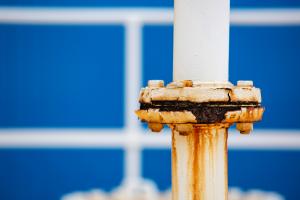
Addressing Corrosion in Construction Materials Caused by Saltwater Exposure
Jules Albert III, owner of Jaymar Construction LLC in Slidell, Louisiana, outlines the implications of salt-induced corrosion on construction materials and highlights strategies to reduce long-term damage.
“Saltwater exposure, whether direct or airborne, speeds up the corrosion cycle on critical building components. Once corrosion begins, it spreads and compromises both the strength and durability of the structure,” said Albert. “Preventing or mitigating corrosion early in the design and construction process is essential in this climate.”
Understanding the Corrosion Process in Coastal Environments
Saltwater introduces chloride ions that accelerate the electrochemical reactions responsible for corrosion. When metal is exposed to oxygen and moisture—especially salty moisture—the protective oxide layer on its surface begins to break down. This allows oxidation to occur faster, leading to rust formation and weakening of the material.
In steel and iron-based materials, this breakdown can lead to swelling, flaking, and eventually structural failure. In reinforced concrete, salt-laden moisture penetrates the concrete surface and reaches the embedded rebar. Once the steel begins to rust, it expands, causing internal pressure that leads to cracking and spalling of the concrete.
Fasteners such as nails, screws, and brackets are often the first components to show signs of corrosion, especially when mixed metals are used without proper isolation. Galvanic corrosion, caused by electrical reactions between dissimilar metals in the presence of an electrolyte like saltwater, is another concern that accelerates failure in joint connections.
Common Areas Affected by Saltwater Corrosion
In coastal construction, the following areas are most vulnerable to salt-induced deterioration:
Structural Steel Beams and Columns: Often used in commercial and residential framing, exposed steel is highly reactive in salt-rich environments without proper coating or galvanization.
Concrete Reinforcement (Rebar): When chlorides reach the rebar inside concrete, corrosion can compromise the tensile strength of the entire structural element.
Roofing Fasteners and Connectors: Roof systems exposed to wind-driven rain and salt mist can experience failure at the fastening points, leading to water intrusion and system instability.
Exterior Cladding and Fixtures: Railings, hardware, and decorative metalwork near the shoreline are subject to early pitting and corrosion.
HVAC Systems and Ductwork: Units installed near the coast or at ground level can experience significant corrosion in fins, coils, and mechanical parts.
Prevention and Material Selection
Material selection is the first line of defense against saltwater corrosion. Builders working in coastal areas often rely on stainless steel, hot-dip galvanized steel, or fiber-reinforced polymer components in high-risk areas. These materials offer improved resistance to moisture and oxidation, though even they require routine maintenance and inspection.
Protective coatings and finishes also play a vital role. Zinc-rich primers, epoxy paints, and powder coatings can extend the service life of structural elements when applied properly. In addition, surface treatments like cathodic protection systems are sometimes used in critical infrastructure to neutralize electrochemical reactions that lead to rust.
When using concrete in marine or coastal environments, additives such as pozzolans and corrosion inhibitors can reduce permeability and extend the time it takes for chlorides to reach the rebar. Proper mix design and curing practices are essential in preventing early deterioration.
Drainage and ventilation are key design considerations that reduce moisture retention around building elements. Structures that allow water to drain and air to circulate freely reduce the likelihood of corrosion-prone conditions.
Maintenance and Long-Term Monitoring
Even with careful planning, ongoing maintenance is required in coastal environments. Regular inspections for rust, discoloration, flaking, or surface bubbling can catch early signs of corrosion before deeper structural damage occurs.
Areas of concern should be cleaned, sealed, or recoated to prevent further exposure. Structural reinforcements may be required when advanced corrosion is discovered in load-bearing components.
Building owners and facility managers in coastal regions are encouraged to schedule routine assessments of metal components, especially in environments that experience consistent salt spray, flooding, or poor drainage. Early detection reduces the cost and complexity of repairs.
Impact on Structural Integrity and Project Lifecycle
Uncontrolled corrosion does more than affect appearance. It compromises the structural integrity of buildings and increases the risk of failure under normal loads or severe weather. Over time, saltwater exposure can degrade key framing systems, jeopardize safety, and shorten the expected lifespan of the property.
Remediation of advanced corrosion typically involves removing and replacing affected materials, which may involve opening walls, removing cladding, or redesigning attachment systems. The financial cost, combined with project downtime, underscores the importance of preventive planning during initial construction.
Morgan Thomas
Rhino Digital, LLC
+1 504-875-5036
email us here
Visit us on social media:
Facebook
Distribution channels: Building & Construction Industry, Culture, Society & Lifestyle, Real Estate & Property Management
Legal Disclaimer:
EIN Presswire provides this news content "as is" without warranty of any kind. We do not accept any responsibility or liability for the accuracy, content, images, videos, licenses, completeness, legality, or reliability of the information contained in this article. If you have any complaints or copyright issues related to this article, kindly contact the author above.
Submit your press release

